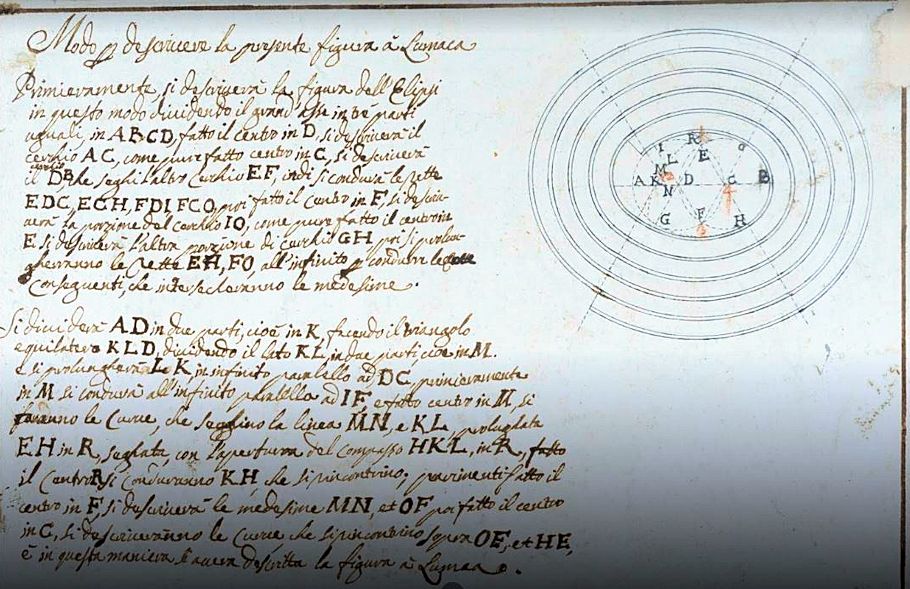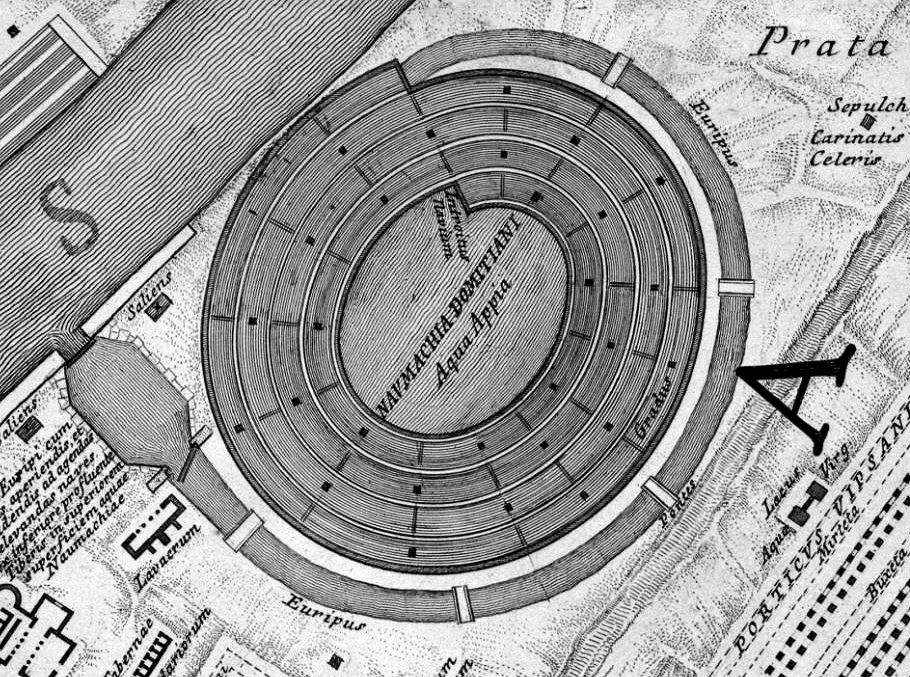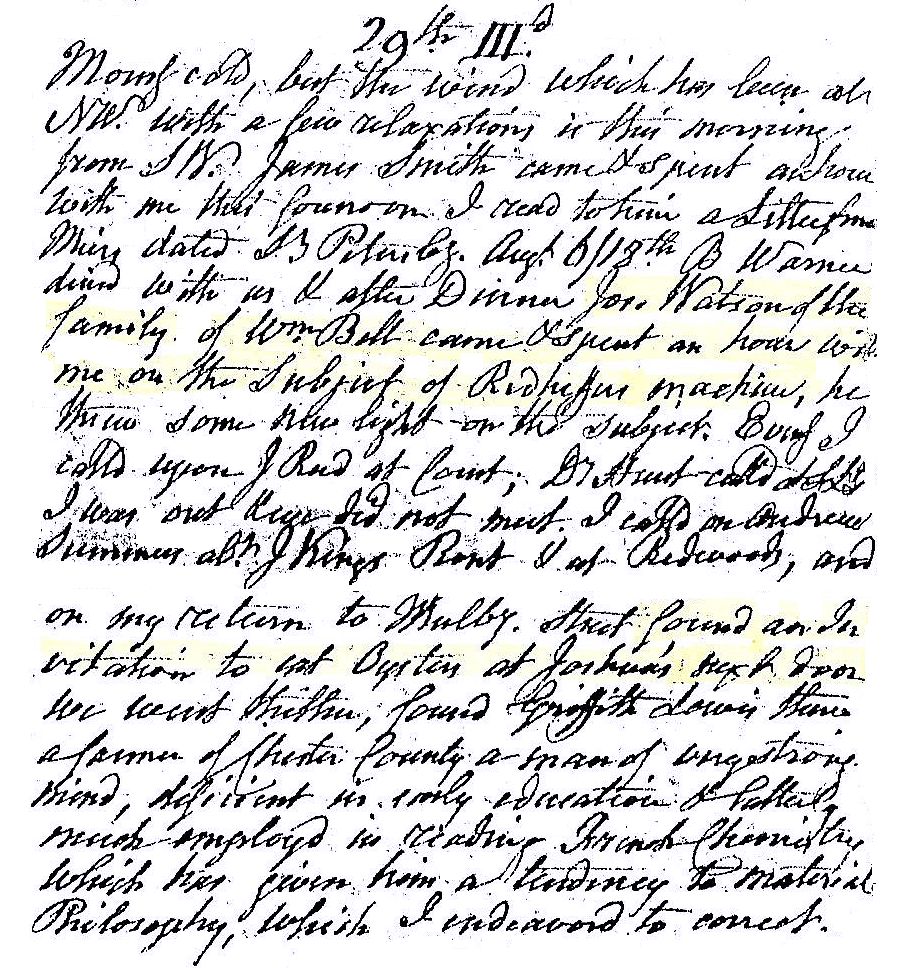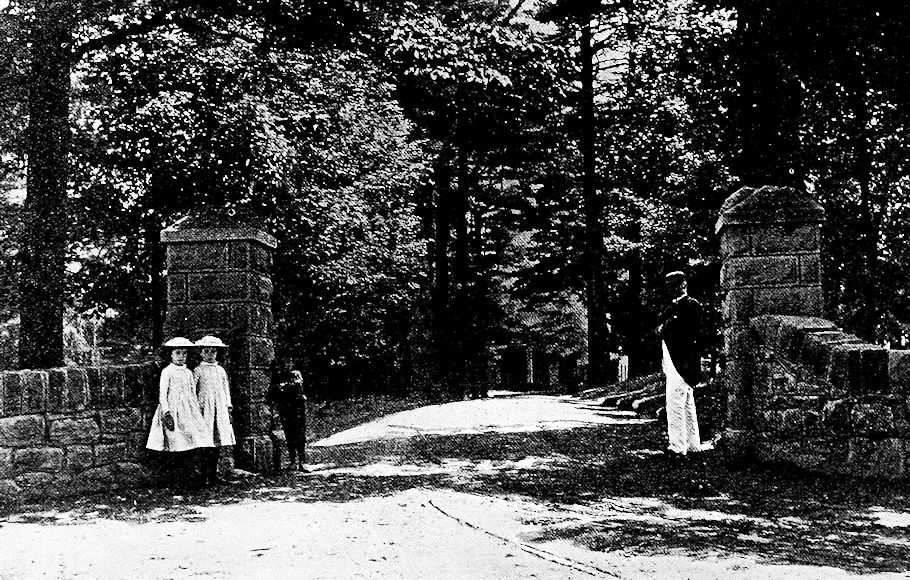29 December 1757

Construction instruction for the spiral "Figura a Lumaca" (c. 1757) by Giovanni Battista Piranesi. Kunstbibliothek, Staatishe Museen zu Berlin.
29 December 1778 Tuesday

Pietro's learning more each day.
29 December 1812 Tuesday

Morning cold, but the wind which has been about NW with a few relaxations is this morning from SW. James Smith came and spent an hours with me in the forenoon. I read to him a letter from Miers dated St. Petersburg August 6/18th. Benjamin Warner dined with us and after dinner Jos. Watson of the family of Wm. Bolt came and spent an hour with me on the subject of Redheffer's machine. He threw some new light on the subject. Evening I called upon J. Reed at Court; Dr. Hunt called as SL's, I was out and we did not meet. I called on Andrew Summers about J. Kings rent and at Redwood's, and on my return to Mulberry Street found an invitation to eat oysters at Joshua's next door. We went thither, found Griffith Lewis there, a farmer of Chester County, a man of very strong mind, deficient in early education and latterly much employed in reading French chemistry which has given him a tendency to material philosophy, which I endeavored to correct.
29 December 1994
Patriarchs of Time
From Macey, Patriarchs of Time, p.2:
“In the subsequent pantheon of Hinduism, Varna gives way to Rudra, who (under the later name of Siva) shares with Vishnu the leadership of the gods. Rudra-Siva develops to the full of those qualities that one might expect from a powerful god of time. In the Svetarvatara Upanisad he is already involved with both creation and destruction on a cosmic scale. Later, in the Maitrayani Upanisad, Rudra’s attribute - as one who both is the author of time and transcends time - is presented in terms of the concept of Brahman: “There are two forms of Brahman, time and non-time. That which was before the [existence of the] sun is non-time and has no parts. Of that which has parts, the year is the form.””
…wonder if the dual nature of the personifications of time and the dual nature of metabolism are both related inextricably to each other, and both are manifestations of an all pervasive dualism that can not be escaped because that, to put it in simple terms, is just the way things are. What I am trying to relate is that perhaps the dual constructive/destructive nature of both metabolism and time, are primal examples of the way the system that we exist within operates… …the dual nature of a constructive/destructive nature in inevitable.
29 December 1997
symbolism of the Porticus Neronianae
I have always found the Porticus Neroniani to carry a significance in that it is an inverted basilica with respect to the basilica of St. Peter's, which it nearly mirrors. I now see its position directly behind the Area Martis (and thus also directly behind the beginning-ending of the Triumphal Way) as additionally symbolic of Nero's reputation as Antichrist.
From Encyclopedia Britannica 16-231d (Peter Astbury Brunt):
"The great fire at Rome illustrates how low his [Nero's] reputation had sunk in 64. He did what he could to relieve the homeless and initiated rebuilding on a much better plan. Yet it was believed, without warrant, that he had fired the city himself in order to indulge his aesthetic tastes in its reconstruction. Nero tried to shift the charge onto the Christians, who were commonly thought to practice all kinds of wickedness. Hitherto the government had not clearly distinguished Christians from Jews; almost by accident, Nero initiated the later policy of intermittent and half-hearted persecution and earned himself the reputation of Antichrist in the Christian tradition."
program of the Area Martis
Piranesi seems to have designed the Area Martis with the writings of Josephus in mind (as cited in Plattus "Passage into the City"). Piranesi calls the immediate zone around the Templum Martis "apparatorium triumphatorium" - place of preparation for the triumphal procession, and the many "tabernae" surrounding the Area Martis seem to be there to accommodate the triumphator and his troops the night before the day of procession. See Plattus p.104-5.
The first arch the procession goes through (and actually the only arch the way goes through within the Ichnographia) is the arch of Trajan. Although there is nothing spectacular in terms of triumph per se that is associated with Trajan, I nevertheless offer the following from Encyclopedia Britannica 19-534 (Howard Hayes Scullard):
"This blunt soldier [Trajan] was later regarded as the most clement of all the emperors, while the title Optimus ("best"), used unofficially since 100 but modestly declined until 114, might then seem to have been won by his services to all sections of the Roman world."
The only other intentionality that I can find on Piranesi's part is the literally "planned" lineage (literally) going from Trajan to Hadrian to Antoninus Pius along the longest axis (of life)--from arch to tomb to arch--which corresponds with the historical lineage of imperial succession. Moreover, with the exception of Nerva, all the emperors from Domitian to Antoninus Pius are clearly "marked throughout the Horti Domitiani (and the Bustum Hadriani). I just noticed that there is a statue of Nerva beside the Temple Plotinae in front of the nymphaeum behind which is the tiny intercourse building.
[Within a couple years I learned that the Arch of Trajan was dismantled and pieces were used, circa 200 years later, to build the Arch of Constantine.]
29 December 1998
imaginations
The imagination of frequency surpasses all other modes of the imagination.
The electromagnetic imagination is the most illuminating and clear.
The osmotic imagination endeavors to find things equal.
The metabolic imagination simultaneously creates while it destroys.
The assimilating imagination is extremely absorbent of data.
The fertile imagination is the most reproductive.
29 December 2006
Any archinecters from Philadelphia?
Over 50 years later, I found out this morning that I now live on "the hill crest of the divide between the Pennypack and the Tacony Creek waters," and where I'm sitting now was in 1763 "an immense peach-orchard, with cows feeding up to the very doors of the house." No cows here right now, but I can go see grazing cows anytime at the farm just over the crest and down the in valley.
Ury House
Ury House is situated upon the Pine Road, on the hill crest of the divide between the Pennypack and the Tacony Creek waters. This venerable mansion, antedating Penn's time, surrounded by an estate of one hundred acres, was purchased by Miers Fisher from the Taylor family at the close of the War of Independence.
Originally a fort built by Swedish Refugees in 1645 [sic], it was enlarged both by the Taylors and Miers Fisher, who bought the place in 1790. The great antiquity of this mansion is shown by its construction and architecture. Two old chimney back plates of iron, one ornamented with the English coat-of-arms and the legend "Dieu et mon Droit," and the other with a plain scroll bearing the date of 1728 are objects of interest to the antiquarian. The latter plate was not taken from the oldest part of the mansion. A plate similar to this is in Governor Keith's house.

The approach to Ury House is by a broad avenue four hundred feet in length, of venerable pines upward of one hundred years of age. The visitor enters through a pillared porch and broad low hall with heavy rafters, which is heated by a large open fireplace surmounted by a mantle of antique design.
There remained a square stone tower, built, as has been testified by comparison, of stone quarried close by. This tower consisted of a curious cellar, approached by solid stone steps leading to a door of wrought iron, supported on either side by tremendous stone drillings. Over the cellar was a square room, from which a steep stairway led to another, and over it, with sloping roofs and reached by a very rickety ladder, was a garret.
It is supposed that this tower was built by those Swedes who sailed up the Pennypack, and was used as a sort of fort and government house, the people living in huts scattered about in the forest, and only coming into the fort in case of an attack from neighboring Indians. [sic]
George Washington is said to have dined in the old hall. [sic--George Washington was never at Ury.]
Miers Fisher gave Ury its name, from the country-seat of Barclay, the famous Scotch Friend and the author of The Apology--"Urie" or "Uri," in Scotland.
About ninety years ago [1802] Mr. Fisher was visited by the daughter of an eminent minister. She thus described her drive from Philadelphia: "We drove through forests from Spring Garden Street to Fox Chase, which consisted of a log tavern with an English sign, on which was painted a picture of mounted huntsmen in red coats, and Nathan Hicks, the proprietor, holding up the foxes that the hounds had killed."
Mr. Miller, who bought "Ury" in 1800 [sic--Miers Fisher owned Ury House until at least 1818], is said to have planted the avenue of pine trees.
Mr. West became owner of "Ury" eight years later [sic], and finally in 1842 Mr. Stephen R. Crawford bought "Ury" of Dr. D. R. Holmes.
In the following year "they" were visited by a queer old woman, who arrived in a very old-fashioned chaise. She said she was ninety years old and a grand-daughter of the Mr. Taylor whose name first appeared on "Ury's" title-deeds. She had come to drink a cup of tea in the old Swede Hall, where she was born. This old woman told Mrs. Crawford that when she was a little girl ten years old [1763], Ury was the center of an immense peach-orchard, with cows feeding up to the very doors of the house.
The mansion is surrounded by spacious lawns and a grove of noble trees of great girth and towering height; while an old-fashioned garden, with its numerous beds bordered by boxwood hedges, is most attractive.
Mrs. Jane Crawford, whose name is so intimately associated with Ury House, and whom many who read this article will recall with loving and grateful remembrance, was born in Edinburgh, Scotland, and came to this country in 1841. After her husband's financial reverses and death in 1863, Mrs. Crawford devoted her life to the instruction of youth, and Ury House became an institution of education, at which many of our leading men received the careful training which fitted them for their future responsibilities.
Mrs. Crawford's rare intellectual attainments, her great executive ability, her refinement and charming grace of manner eminently fitted her for her position as the head of a large and prosperous school. Only those who knew her well can appreciate the beauty of her character, the gentle firmness and loving care with which see guided those under her instruction. After a successful existence of twenty-one years, Mrs. Crawford gave up her school, and Ury House passed into the hands of her son, Mr. Joseph U. Crawford, an officer in the Pennsylvania Railroad, who now occupies as a private residence the old mansion in which he was born.
Rev. S. F. Hotchkin, M.A., The York Road, Old and New (Philadelphia: Binder & Kelly, Publishers, 1892), pp. 406-10.
Ury House 2018
The notion that Ury House was "originally a fort built by Swedish Refugees in 1645" can be traced back no further than 1892, when the Reverend S. F. Hotchkin, in The York Road, Old and New, introduced the idea of Ury House being of Swedish colonial origin. Earlier, Townsend Ward, in the 1880 article "Second Street and the Second Street Road and their Associates" published in The Pennsylvania Magazine of History and Biography Vol. IV, states, "The old house on the place is supposed to have been erected prior to 1700, and this seems probable, not only from the great thickness of the walls, but also from the lowness of the ceilings which are but six and a half feet in height," and "A deed of 1728 recites that the Taylors had held the land at Ury for a time beyond the memory of man." Simply put, the history of Ury House prior to 1728 is only supposition and likely to remain an open question. As someone who presently lives three hundred feet southeast of where Ury House stood, I'd like to present a more responsible history of Ury House and this place.
Stephen Lauf
29 December 2022 Thursday
. . . . . .
|